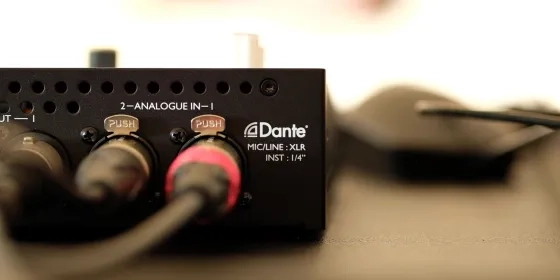SFCM pioneers tech solution so orchestras can safely perform together
Dante Audio Networking System offers ensemble players virtually no audio latency
Soprano Alissa Goretsky's ‘21 first vocal coaching since COVID-19 struck at was anything but typical.
"My teacher called me and asked if I wanted to try something out with him," she recalled. "So I showed up to a conservatory room, and there was a microphone and a pair of headphones on a table," she recalled. "My coach and teacher were in other rooms in the building with a similar setup."
After warming up with some scales, she sang through a Mozart aria with her pianist performing in real time in a different space, another microphone capturing and mixing the sound in everyone's headphones.
“You're not in the same room, but it's almost like you are.”
With COVID-19 preventing musicians from gathering safely in larger numbers, many performers have turned to technology as a means of playing together. Still, individuals had to record their parts separately, combining them later into collage-style videos—the quality and lag inherent in current technology prohibited clean, simultaneous live performances.
Until now, that is.
"Once we realized we were in sync we just said 'wow.' This is impressive," Goretsky said. "You're not in the same room, but it's almost like you are. Being back in that space at SFCM was just amazing after so long away."
The system supports far more than just two players. "Sept. 29 was our first Dante system test with the full orchestra," said Taurin Barrera, Acting Executive Director of Technology and Applied Composition at SFCM.
He's referring to a network of linked microphones using Dante audio technology in about 30 different practice and ensemble rooms at the conservatory that allow for synchronous performances. "It's uncanny to have a full orchestra playing together again in this day and age," he said, noting that the orchestra read through a new work by alumnus and philanthropist Gordon Getty.
“The sound quality is better than CD quality at 48,000 samples per second, and Barrera said the latency is only about 4-10 milliseconds, short enough to perform in real time with one another.”
SFCM is the first conservatory in the U.S. to have solved the issue of socially distanced large ensemble playing.
Staff members spent several weeks this summer installing the technology. Where previously this would have required an unfeasible number of wires and mixing, the Dante system condenses all of the cordage to a single ethernet cable that places each mic on the same network. "It's almost like an internet of musical devices," Barrera said. Currently the tech is audio only, but the conservatory has CCTV (closed circuit television) systems built in as well which allows for some video elements as well.
With 30 networked rooms, teachings and coaching sessions and rehearsals for 2-30 people can once more take place. The sound quality is better than CD quality at 48,000 samples per second, and Barrera said the latency is only about 4-10 milliseconds, short enough to perform in real time with one another. "You don't even think about the tech when you get into a flow state of making music," he added. "We planned to add Dante to the new Bowes Center building about four years ago, which is still under construction. Then with COVID-19, we realized this would be a perfect solution for socially distanced performing and decided to retrofit the current building."
Goretsky concurred, noting how easy and effective the system is to use. "There's a dial to adjust your volume or their volume, and I kept my left ear open to hear myself and a headphone on my right ear to hear the piano," she said. "I'm really looking forward to doing it again."
This fall, the Conservatory is charging forward with an ambitious calendar of performances featuring concerts by large and small ensembles alike, many of which will be facilitated using Dante. "We're dreaming up new ways to present music using this system," Barrera said. The tech also supports day-to-day operations like lectures and recording. Dante's technology has risen to the top of steep competition between various audio-visual networking formats in recent years and is now fairly ubiquitous in recording studios.
"We're kind of at a crossroads in the audio world between analog and digital," Barrera said. "The classical world has traditionally been an analog experience. In the spring time all this tech became a part of all our music making. This is actually a great opportunity to show how mic techniques and being comfortable with digital audio is a significant part of a musicians' career in 2020."
Browse this season’s virtual concert series.
